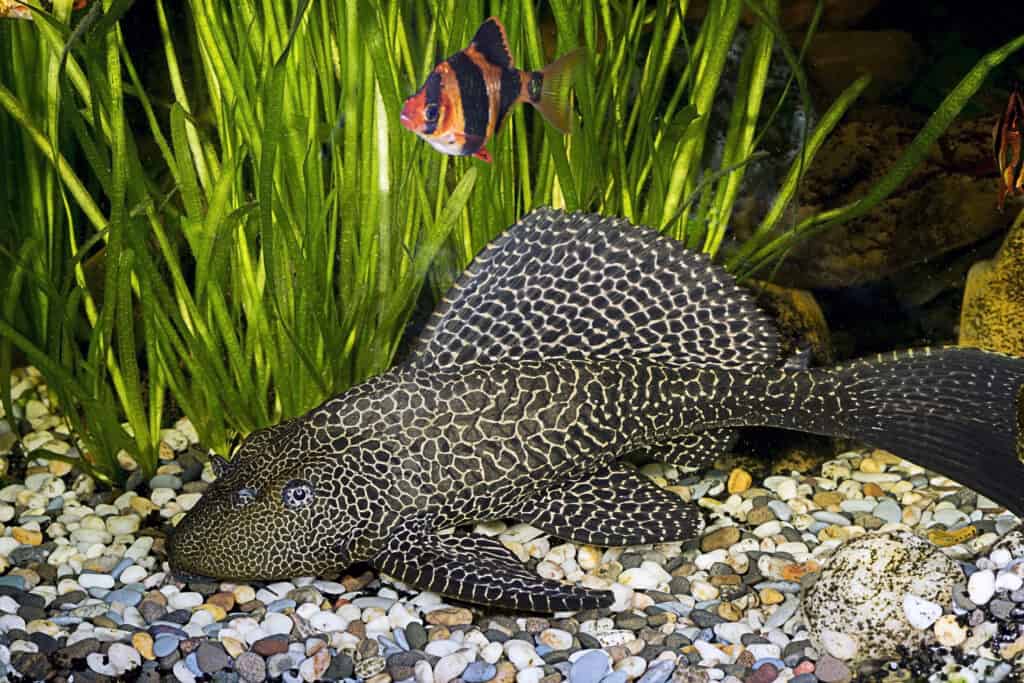Armored Catfish
Advertisement
Armored Catfish Scientific Classification
Read our Complete Guide to Classification of Animals.
Armored Catfish Conservation Status
Armored Catfish Facts
- Other Name(s)
- Plecos
- Optimum pH Level
- 6.5 to 7.8
- Average Spawn Size
- Several thousand eggs
- Habitat
- Freshwater (and sometimes brackish)
- Predators
- Fish, Birds, River Otters, and Crocodiles
Armored Catfish Physical Characteristics
- Color
- Brown
- Grey
- Black
- White
- Dark Brown
- Lifespan
- 5-8 years
- Weight
- Up to 3 lbs
- Length
- 6-8 inches
- Age of Sexual Maturity
- Usually 4-6 months
- Venomous
- No
- Aggression
- Low
View all of the Armored Catfish images!
The Armored Catfish is a seriously invasive species that was originally from South America.
Armored Catfish is the common name used to describe the largest family of catfish, loricariidae. They are known for the bony plates that cover their body.
These fish look like a typical catfish with whiskers and suckermouths and are bottom feeders just like you’d guess a catfish to be. Furthermore, they are a popular aquarium fish and are often called “plecos.”
4 Armored Catfish Facts
- Armored Catfish have plates of armor or bony plates that cover their body. These protect the fish from predators as they lay flat against a rock or the bottom of the river or stream.
- Armored Catfish have strong pectoral fins. They can extend these fins to make their overall size larger so that they are harder to fit in the mouth of another fish or bird.
- While they have gills like normal fish, they can also gulp air and hold it in their stomachs. When outside of water, this allows them to breathe for up to 30 hours outside the water.
- During drought conditions, Armored Catfish have been known to “walk” or shuffle across the land for short distances to get to areas with more water. Their strong pectoral fins, flat body, and ability to breathe out of the water allow them to accomplish this.
Armored Catfish Classification and Scientific name
Armored Catfish are the largest family of Catfish (Loricariidae). In this family, there are 92 genera and just over 680 different species. Furthermore, Loricariidae is one of seven families in the superfamily Loricarioidea.
Some of the fish in the other families also have armor and suckermouths, but not both like Loricariidae. They are commonly called Loricariids, with several genera called “plecostomus” or just “plecos” that are sold in pet stores as aquarium fish.
The Hypostomus plecostomus was one of the first species imported as an aquarium fish.
Types of Armored Catfish: The 680 Different Species
As mentioned, there are over 680 species of Armored Catfish in the family Loricariidae. Some of them are:
- Hypostomus plecostomus: Commonly referred to as the “pleco,” this is a common fish in the aquarium fish trade. Pet owners have these to clean the aquarium from algae and other contamination. They are also difficult for other fish to harass due to their docile demeanor and thick armor.
- Hypoptopoma guianense: Small Armored Catfish that live in Guyana in the Essequibo and Nickerie river drainage. It only grows to about 2.5 inches long.
- Proloricaria prolixa: Armored Catfish endemic to Brazil’s upper Parana River Drainage area. They can grow up to 13.8 inches long.
- Pterygoplichthys multiradiatus: Commonly known as Orinoco Sailfin Catfish. It has a sail-like dorsal fin and is known for its speckled appearance. It is a popular “pleco” fish for aquariums.
Armored Catfish Appearance
Armored Catfish appear to be typical catfish from a distance. As you’d expect, they have a large suckermouth that faces downward, allowing them to attach themselves to surfaces through suction. They also have “whiskers” like a cat, called Maxillary Barbels. Unlike a cat, these are sensory organs that help the fish find food.
The bony plates covering their bodies set Armored Catfish apart from normal catfish. Some species may only have the plates in certain areas, mainly on their back, while others have them all over their body. When threatened, these bony plates help to protect the fish from predators.
Since this is the largest catfish family, there are many colors of Armored Catfish with various patterns and body shapes. Some of the smallest are about 1 inch long, with the larger fish growing to 39 inches long.
Typically, they also have a wide body with wide pectoral fins. When threatened, they can lay on the surface of a rock or along the bottom of the body of water and spread their fins out to become difficult for other fish to eat.
Many species have a modified eye called an Omega Iris. A segment of the iris expands downward over the pupil to create a loop that looks like the Greek letter Omega. When light levels are high, this reduces the amount of light transmitted into the eye. It has also been suggested that this offers an amount of camouflage and breaks up the outline of the eye.

The Armored Catfish is a favorite for aquariums, as it is a bottom feeder and helps remove algae.
©iStock.com/amarinchenko
Armored Catfish Distribution, Population, and Habitat
Where to Find Armored Catfish and How to Catch Them
Originally, Armored Catfish were tropical fish from the freshwater habitats in South America. In the 1950s, they became a popular part of the aquarium trade and subsequently were released into the wild in various parts of the world.
They are now an invasive species in Florida, Texas, and Mexico. In some Texas rivers, it is believed that they make up 50% of the total fish biomass.
Depending on the size, they can be found in nearly any type of slow stream, pond, lake, or canal. Mostly, they are found along the shoreline and in shallow waters. Catching the smaller fish is typically done with a net; sometimes, the larger ones are caught with a rod and reel using live or artificial bait.
However, the number of fish in the wild is unknown. In non-native areas where they are invasive, it is common for governments to encourage removal from the habitat. There are no limits on catching them, and laws often dictate that they cannot be returned to the water.
Armored Catfish Predators and Prey
Mostly, Armored Catfish eat algae, invertebrates, and any other small organic matter. This makes them well suited to “clean” aquariums, which is why they are popular in the aquarium fish trade. Furthermore, some species are known for their ability to digest wood.
What Do Armored Catfish Eat?
They eat algae, small invertebrates, and other organic waste they find at the bottom of their habitat.
What Eats Armored Catfish?
Predators include other larger fish, birds, river otters, and crocodiles. However, humans are predators, mainly for the aquarium trade but less often for food.
Armored Catfish Reproduction and Lifespan
Armored Catfish have many different species, and their breeding habits can vary. However, the most common is burrowing into the shoreline and creating an area to lay their eggs.
Sometimes, these burrows can be up to three feet deep and destroy the shoreline.
Twice a year, females lay several thousand eggs in the burrows. During the breeding season, the males guard the nest until the eggs hatch around 20 days later.
Armored Catfish in Fishing and Cooking
Typically, Armored Catfish are not pursued in recreational sport fishing. Since they feed on algae and small organic matter, it is not as easy to catch them with a rod and reel.
However, some larger species that eat small invertebrates can be caught with natural bait such as worms or artificial bait such as a “pig and jig.”
A pig is an artificial lure that looks like a small frog and is heavily scented. This is placed onto a hook of a jig that is simply a hook with a small head painted to resemble a minnow head. Usually, there is also a skirt around the hook made from strips of colored plastic.
Due to the bony plates, Armored Catfish are not easily cleaned for cooking. The body can be split open like a crab, or the meat can be cut away from the skin. The meat is white and flaky. However, it usually does not have much flavor, depending on the water the fish lives in.
Because of the difficulty in catching, the difficulty in cleaning, and the lack of flavor, there is no real market for Armored Catfish as food in the United States. In Brazil, especially in rural areas, they are sold live in markets and commonly eaten grilled or in soups.
You can click here for more information on catching and cleaning these fish.
Similar Species
View all 194 animals that start with AArmored Catfish FAQs (Frequently Asked Questions)
Where are Armored Catfish found?
Armored Catfish are native to South America, and can be found in most of the freshwater streams, rivers, and ponds throughout the continent. They can also be found in Florida, Texas, and Mexico where they are an invasive species.
Thank you for reading! Have some feedback for us? Contact the AZ Animals editorial team.
Sources
- Los Angeles Zoo / Accessed September 16, 2022
- Wikipedia / Accessed September 16, 2022
- Coastal Angler Magazine / Accessed September 16, 2022
- Eat the Invaders / Accessed September 16, 2022


















